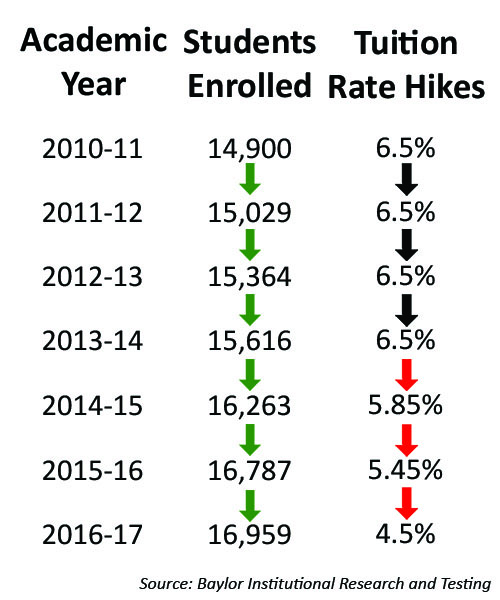By Gavin Pugh | Editor-in-Chief
Baylor’s tuition rate will stay a set percent increase of 4 percent beginning in the 2018-19 academic year, which completes the tuition step-down plan originally implemented in 2013, said Lori Fogleman, Assistant Vice President for Media Relations and Crisis Communications.
The plan, originally proposed by student leadership and implemented by the Board of Regents, has seen a 2.25 percent decrease in tuition hikes over the past four years, Fogleman said.
The tuition hikes were at a steady 6.5 percent increase before the plan was implemented. For the 2017-18 academic year, students taking at least 12 hours will pay $19,805 for the fall and spring semesters.
As it stands, student enrollment has increased by 8.6 percent since fall 2013. With that growth in mind, Port Barre, La., senior and Student Body President Lindsey Bacque said she hopes Baylor can provide all students with what they need.
“As the student body grows, we need more resources and amenities to provide them with,” Bacque said.
Bacque noted it can be difficult to meet these students’ needs due to the financial strains put on the university by the growing student body.
As the student body grows, Baylor needs more resources, and because Baylor needs more resources, it needs more money to purchase these resources, which means it needs more students to enroll, Bacque said.
Dr. Reagan Ramsower, senior vice president and chief operating officer at Baylor, is responsible for determining and proposing the annual budget to the Board of Regents.
These tuition funds are majorly responsible for the university’s ability to function, with two-thirds of all revenue coming from tuition, or roughly $600 million out of the $915 million in revenue as reported on Baylor’s 2014 990 form.
Students have an option to mitigate some of the effects of the tuition increases beginning their freshman year with the Guaranteed Tuition Option as outlined by the university’s student financial services’ site.
“The 2017-18 Guaranteed Tuition Option is designed with the intention of providing a material discount to undergraduate students who elect to participate,” the financial services’ site says. “The actual value of the benefit will depend on how tuition rates are set by the University over the next three years, but an undergraduate’s savings is projected to be $2,000-$3,000 over the four-year enrollment period.”
These savings do not include fees, however. For the 2016-17 academic years, fees totaled to $4,180 per student enrolled in 12 hours or more. At 16,959 enrolled students, this equals out to a little over $70 million.
As to where these funds are dispersed, the records are not publicly available. The allocated fees, however, can be seen in bits and pieces. Student government, for example, is given a $215,000 annual budget, said Arlington junior Marcus Maurer, student government finance chair.
Maurer said the student government allocation fund is a percentage of the annual student fee budget, where all the student fees are brought together and distributed accordingly. The allocation fund varies based on student enrollment and the fee for that academic year.
While students face continually increasing tuition prices and fees, Baylor might be directly affected by Senate Bill 1092.
As previously reported by the Lariat, Senate Bill 1092, proposed by State Sen. Kel Sigler (R-Amarillo), requires any university receiving more than $5 million in Tuition Equalization Grant money to comply with open meeting and executive session laws, regardless of private or public status.
Interim President David Garland testified at a Texas Senate Higher Education Committee meeting in March, saying that 2,943 Baylor students receive aid from the Tuition Equalization Grant, 1,597 of which are from minority populations and 962 are first-generation college students, as previously reported by the Lariat.






